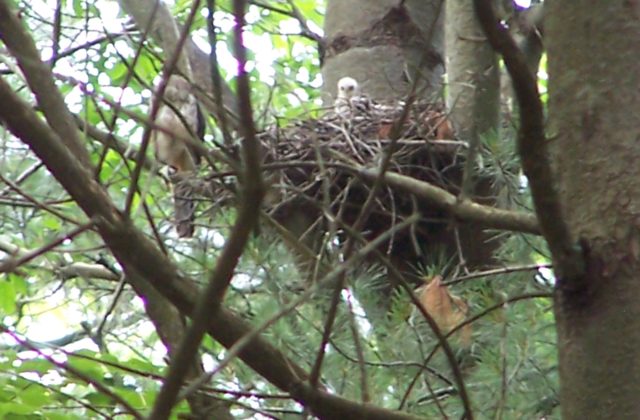It’s Only Natural: The Summer of the Cooper’s Hawks
By Ayreslea R. Denny
This is the story of the Cooper’s hawks that raised a family in our woods last summer. Just recently removed from the State’s list of Species of Special Concern, this species is making a comeback in Connecticut, but it is still a rare privilege to be able to observe them this closely.
In late March of 2006, we saw a pair of Cooper’s hawks flying over the Christmas trees and the house. In April we heard their calls (whaa & kik kik). By April 20, the nest was all built. Charlie [Tirrell] spotted it first — about 30 feet up in a White pine at the junction of two wood roads, in a stand of White pine and some deciduous trees. It was about 150 feet from the edge of our yard.
On April 23, ornithologist Bob Barbieri came and confirmed they were Cooper’s hawks. The larger female was in second year plumage, the smaller male in stunning adult plumage. The female sat on a deciduous tree’s branch calling while the male was deep in the pines calling and sometimes flying through the branches.
The rains came in May and we decided to avoid getting near the nest and hope for eggs. Occasionally, we saw hawks near the nest.
 It wasn’t until June that we realized how camouflaged the hawks were in the nest. The nest sloped toward the tree trunk (and thus a bit away from our seeing position), higher on the outside and curving around the trunk to our left. On the right side a smaller limb curled to the right, leaving a space for a roosting hawk to barely be seen.
It wasn’t until June that we realized how camouflaged the hawks were in the nest. The nest sloped toward the tree trunk (and thus a bit away from our seeing position), higher on the outside and curving around the trunk to our left. On the right side a smaller limb curled to the right, leaving a space for a roosting hawk to barely be seen.
On June 13, we saw the female settle into the nest, and on the 17th I saw the male feed the female on the nest. On the 19th, the adults were tearing food and feeding chicks! Two white fuzzy chicks with wings waving appeared to tear at the food as well as being fed by both parents.
We could hear a quiet “kuk kuk” communication between the adults. The male would get prey and bring it to the female, who was the main feeder at the nest. She would hunt as well.
In late June, we saw four chicks! They would back up to the edge of the nest and shoot excrement over the side.
In July the female was molting and preening constantly. The oldest two chicks looked like black and white checkerboards with black eye lines. All the chicks ripped into the prey with the smaller two being fed by the adults as well. The oldest got the food first and stood aside as the younger two got fed.
How quickly they grew. By mid-July, all of them were flapping, the two oldest had streaking on their breasts, the others were grayish and fuzzy still. The nest was crowded and the adults got bumped. The two oldest wobbled about the edge of the nest. They called quietly back to the adults’ calls. The eldest (female is my guess) was huge and looked like a hawk. No more a chick!
By the end of July, the four young hawks were all over the pines. Sometimes they would eat at the nest. At night they roosted near the nest. On August 5 at 9 p.m. there was a very loud backfire. We heard the hawks call as if startled.
They seemed to be hunting. Robin [Denny] saw two near their house down the road, and one got a bird. Do they help each other hunt?
The adults disappeared in mid August. The four young (my guess is three female and one male, based on size) careened around our yard, perching on the roof, screaming, flying down to the willow and up to the pines.
Then they were gone on August 20, just four months from the discovery of the nest. The next day the Mourning Doves and Blue Jays returned to our yard after months of being away.
Photo by Shelley Harms.

